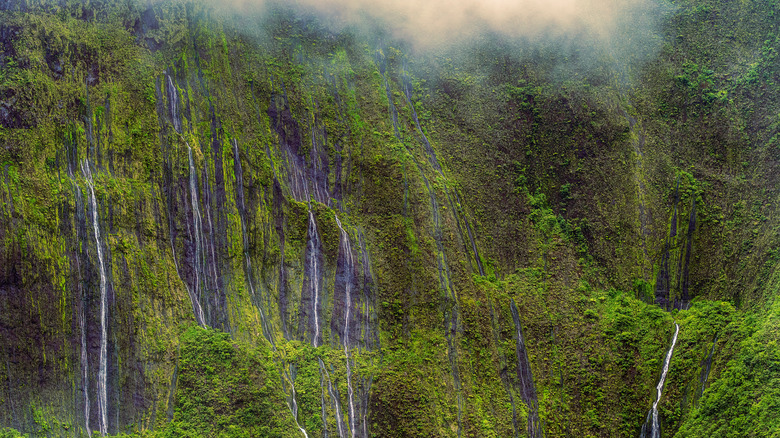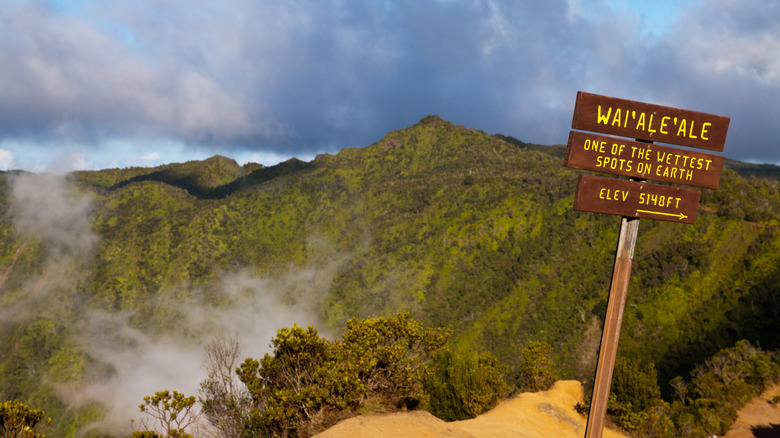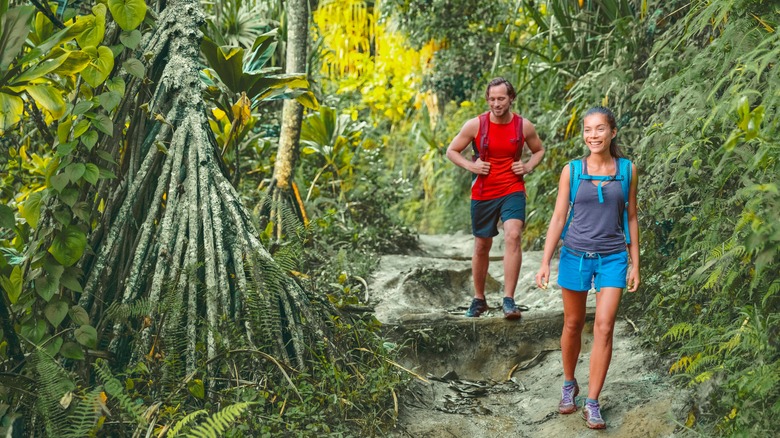This Beautiful But Dangerous Hawaii Hike Leads To One Of The World's Wettest Destinations
Kaua'i — the oldest island in Hawaii — conceals a hidden treasure: a unique, green-clad canyon that epitomizes the island's lush beauty. Accessible solely on foot, this natural paradise offers a breathtaking experience with a dangerous catch as it leads to the Weeping Wall — one of the wettest places on Earth, drenched with 450 inches of rain each year. The Weeping Wall is part of Mount Wai'ale'ale ("rippling water" in Hawaiian), a colossal 5,148-foot dormant volcanic mountain encircled by countless cascading waterfalls.
These waterfalls are the result of localized (and relentless) precipitation. To put it in perspective, the area only a few miles away barely gets 10 inches of annual rainfall! This phenomenon occurs because the east-west winds from the Pacific Ocean become trapped against the slopes of Mount Wai'ale'ale, effectively becoming a "trade wind inversion layer" where clouds simply cannot rise any higher. This, combined with dampening winds and steep cliffs that cause high humidity, makes Mount Wai'ale'ale the unusually wet place that it is, and the only way to experience it is by hiking.
Unfortunately, there is no official hiking trail, making this U.S. trek extremely dangerous, particularly for inexperienced hikers and travelers. However, for those eager to take on the challenge, the journey often begins at the Kuilau Ridge trailhead. Here, a parking lot offers a moment to decide whether to embark on a 3.5-mile journey offroad or hike to the gates of Jurassic Park — a nod to Kauai's role as a filming location for Steven Spielberg's 1993 classic.
Mount Wai'ale'ale, the Weeping Wall, and its dangers
The hike spans approximately 15 miles with a 3,000-foot vertical gain. Although it may not seem so bad at first, the trail's difficult nature becomes evident once you reach the 5-mile mark. Dirt pathways will grow narrower, steeper, and increasingly overgrown, requiring a high level of physical fitness and hiking experience. The mountain's geographical location, slippery cliffs, and frequent rainfall create a perfect storm of hazards.
For starters, due to the constant wet conditions, this adventure will often force you off your intended path, with frequent diversions caused by flooding and spillways. At times, you'll need to fully submerge yourself to cross. In other instances, you might manage by scrambling over wet rocks. Most recently, three people have fallen to their deaths, including a 66-year-old man, 30-year-old man, and 28-year-old woman, while hiking a similar trail within Kaua'i. With limited cell service and the remote location of the trail, there are few options for safety or rescue in case of an emergency.
Another danger? Sudden and severe weather changes, including flash flooding, which can transform the trail into a dangerous torrent in minutes. It's crucial to check the weather before setting out. If the weather does take a turn, here are some alternative rainy day activities in Kaua'i. Hiking during heavy clouds and rainfall is not only dangerous and cold but will also rob you of stunning views that are likely one of the main reasons for your journey.
Is the hike worth the risk, and what can you do to prepare for it
For those willing to commit to the hike, the trek to Mount Wai'ale'ale's Weeping Wall offers an otherworldly experience at one of the wettest places on Earth — it's also one of the best and most extreme outdoor activities you try on your next trip to Hawaii. However, the risks are real and life-threatening — safety ultimately comes down to you. If you're interested in taking it on, consider hiring a local guide. This will increase your chances of a safe and successful hike while still giving you that sense of reward when completing it. Services like Kaua'i Hiking Adventures offer experienced guides who can lead half-day treks, giving insights about the terrain, wildlife, and history of this place. Bear in mind that the Weeping Wall is sacred to locals, so please be respectful at all times.
Regardless of whether you have a guide or are trekking independently, it's crucial for hikers to bring at least a full day's worth of food and water. Flash flooding can leave you stranded for hours, so having provisions on hand is essential to wait out the storm safely. Consider carrying a portable water purifier, as this can save you some weight by allowing you to pack less water and safely drink from natural water sources along the hike. Equally important are your shoes — be sure to wear waterproof footwear, ideally providing both protection and traction to navigate the challenging terrain.


